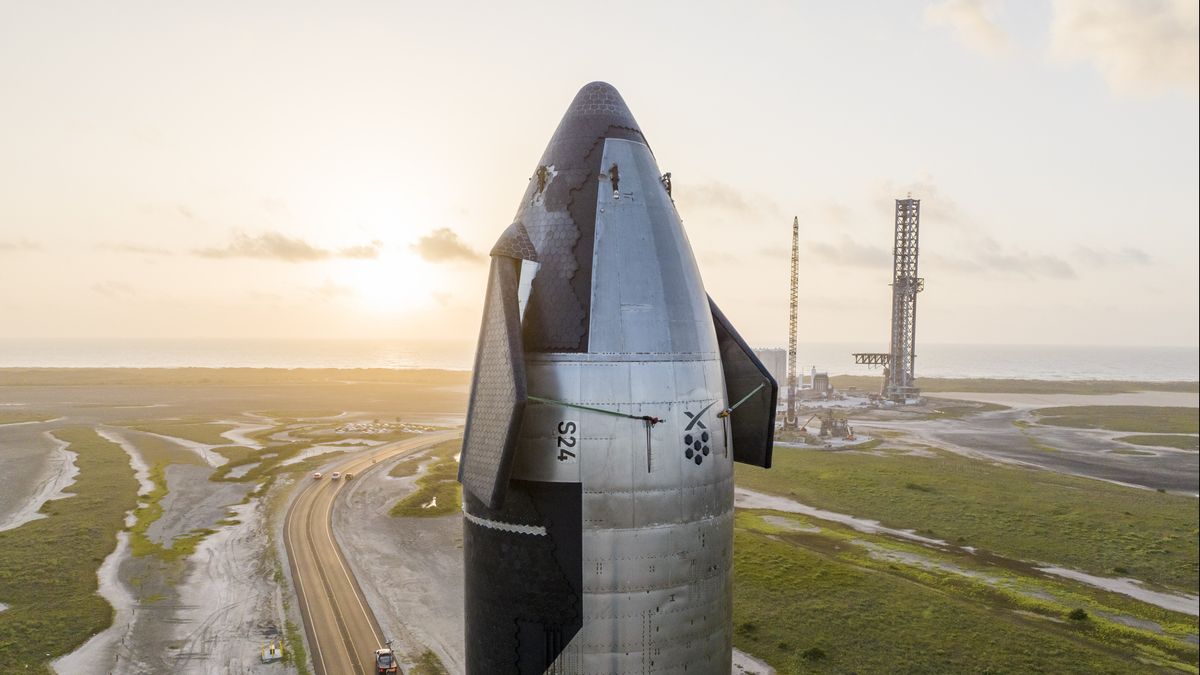JAKARTA - Elon Musk promised the world of Starship flights to be ready to orbit this July. It seems that he is also one step closer to realizing his ambition.
SpaceX, Wednesday 6 June announced its prototype, or Ship 24, standing upright on its suborbital cushion in its Starbase in Boca Chica, Texas.
The move is 'in preparation for Starship's first orbital flight test,' SpaceX said in a tweet.
Ship 24 was transported to the pad at Starbase in preparation for the first orbital flight test of Starship pic.twitter.com/xm5H8wBmUx
— SpaceX (@SpaceX) July 6, 2022
All activities at testing facilities have been suspended for more than a year due to an environmental review by the Federal Aviation Administration (FAA).
According to an FAA report, SpaceX is required to 'take more than 75 measures to reduce the environmental impact of its proposed plan to launch a Starship - Super Heavy- before it can launch another rocket on the site.
This includes killing plans to build desalination of natural gas power plants and polling and disbursing natural gas facilities at or near the launch site.
However, SpaceX did receive approval up to 500 hours of road closure for operations and up to 300 hours for road closures for emergencies per year.
This is a win, as the company is only given 180 hours per year for the launch of the Falcon 9 rocket in 2014.
The FAA report was published on June 13 and the next day, Musk tweeted: 'Starship will be ready to fly next month.'
He also tweeted on June 14 that SpaceX 'will have a second Starship stack ready to fly in August and then a monthly month later.'
However, it appears Musk's company has received approval from the FAA and is moving forward with its first Starship orbital launch.
The last Starship that flew was Series Number 15 (SN 15) on May 5, 2021 and landed safely. However, from several trials, not all rockets have returned to Earth intact.
Humanity will reach Mars in your lifetime
— Elon Musk (@elonmusk) July 6, 2022
The test flight earlier, on March 31 last year, ended with SN11 on the launch pad.
SN10 was the first of the previous four Starships to survive the landing, but the massive rocket exploded approximately 10 minutes later due to methane leakage.
Failure occurred after SpaceX declared it successful, as the SN10 flew over and overturned, without hitting and burning like the previous SN8 and SN9 prototypes. Musk praised the rocket in a tweet for 'landing intact'.
And both SN8 and SN9 exploded into fireballs as they landed, and both sparked reviews from the FAA due to environmental impacts.
SpaceX plans to send humans to Mars using a two-stage spacecraft consisting of a Starship (passenger share) and a Super Heavy rocket booster.
However, SpaceX has some work to do to complete the construction of the Starship worth 216 million (Rp 3.2 trillion), formerly known as the 'BFR', at the SpaceX Texas development site.
Musk wants to use Starship testing to complete the final rocket to bring humans to Mars and orbital launches will bring the billionaire one step closer to colonizing the red planet.
Starship will complete all the missions Musk announced in 2016. SpaceX CEO said the rocket would make its first trip to the red planet in 2024. The first trip was only cargo. Then followed by a manned mission in 2026 and claimed another SpaceX product would be 'ditibal' to pay for it.
The rocket is partially reusable and capable of flying directly from Earth to Mars.
Once built, Musk believes the rocket can be used for travel on Earth - saying that passengers will be able to go anywhere in less than an hour.
To date, the Starship rocket circuit has made 9 test flights some of which resulted in successful short jumps, while others caused explosions or emergency landings.
The latest experimental launch, involving the prototype of the SN15 Starship, took place on May 5, 2021 and saw the aircraft complete flight tests of an altitude of 33,000 feet to lowland clouds, complete with successful climbing, engine cutting, counter maneuvering, ramp control and soft touchdown. Small fire did erupt at the bottom of the rocket after landing, but then went out.
The English, Chinese, Japanese, Arabic, and French versions are automatically generated by the AI. So there may still be inaccuracies in translating, please always see Indonesian as our main language. (system supported by DigitalSiber.id)









